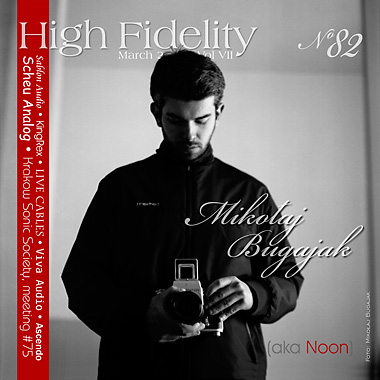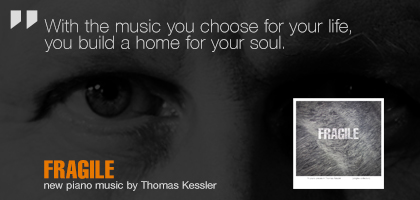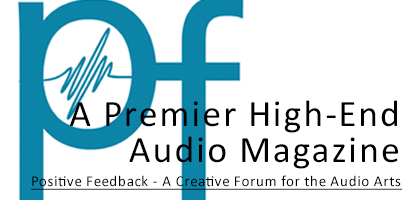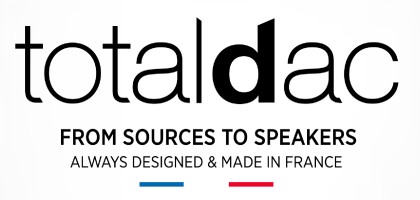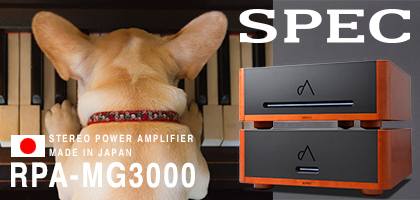CRIPPLE ORIGINAL

I think, that everybody knows someone who can be called “original or eccentric”. At least those of you, who were born in the last century. An original is somebody who differs from the median of a given society. But – let’s say – he was validated in a positive way – his or hers status was a few degrees above freak and changeling. With those two there was a link in terms of being different to the environment, and a certain “individuality” – there is no other like that one. In this view, this original is a positive guy, although treated with a slight distance. But a completely different case is with an original in art.
According to Encyclopedia of Gazeta Wyborcza, an “original” is “a document in its primal, authentic version, material and content; archetype, authentic piece”. So it can be exchanged for another word – ‘authentic piece’. And in this meaning it is usually used in the world related to music recording, of which audio (hi-fi, audiophilism) is part of. I would like to have a closer look at that.

In art only the original things count. The original of a painting is the ONE and only painting, we are talking about, all others are only copies, fakes and forgeries. Only the originals count, everything else is crap. You know what I mean.
It is harder with other areas of art, where there is no original – like in photography, especially the digital one. In analog photography it was simpler, because the old negative was the original, although developing it created irreversible changes. But we can assume, that we could not enjoy non-developed film, so the negative became the original. So what were the prints? – They were only copies of the original, something secondary.
And yet it seems, that many of the artists treat those prints as originals. But we could imagine a situation, actually a very usual one, when there are more prints. So which one is the original one? The master? – In fact each of the analog prints is different, right? To find ways around that situation, in practice the following solution was found: the artist develops a certain number of prints from a given negative, numbers them and signs them. And those are the originals.
In case of digital photography the thing is even more complicated, because each digital copy is identical to the original. The theory of signals tells, that each copy will be slightly different, but for the sake of our example, it is better to assume, that we deal with identical copies – differences between digital copies are far smaller than between analog ones. Here you can see, that each of the numbered copies will be identical, or at least so similar, that it will be undistinguishable without specialist research. So the artist will decide what is the original in an arbitrary decision process.
This uncertain situation of the original is well shown by the printout of a computer graphic I own, created by Zdzisław Beksiński. The magazine “Sound and Vision”, for which I worked some time ago, made an interview with the artist – unfortunately deceased now. Because this interview was mainly about his artistic work, as he just started working with computer graphics at that time, the magazine received a dozen of his works on a CD-R. We received also a permission, to print each of the works once for ourselves, privately. And I own one of those. But from the very beginning we knew, that those were no originals, but copies – they do not have a signature of the author, etc. This is a copy, although identical to the original.

And what is the original in the audio branch, in audiophilism? I will try to show you, that this is not a nonsensical question. It touches the heart of the problem, which we usually do not see, or think about. Let us think about, what is a disc with a recording of an artist. We can see quickly, that it is a copy. First a copy pressed from a stamp, then a copy from a master tape (or in case of a hard disk recording – from a original recording). But this is only the starting point.
According to the Dictionary of literary terms “originality is a gradated characteristic […] and at the same time a relative one […]” (red. Janusz Sławiński, Wrocław, 1988). To make it clear – it is about the originality of a piece of literature, and not a piece of art and it relates mostly to the definition I mentioned in the beginning. However this approach will come handy, especially as it corresponds with another kind of originality I omitted – the mentioned Encyclopedia of Gazeta Wyborcza shows as the second description: “a qualified crop seed, received from breeding highest quality seeds – the elite”. It is obvious, that this definition is about agriculture. But even this shows, that originality is something contractual, and it can be gradated.
|
Now to the point – I will ask once again: what is the original, when we talk about a recording? The first reaction, based on other domains of art, is – at least I think so – that the original issue of that piece (I am talking about recordings and their editions, and not performance), made with acceptance and knowledge of their authors. This is how science talks about literature – the main issue, the “canonical” one, is the last one made while the artist was still alive. There are exceptions to the rule, but this is how it goes. It is assumed, that the author has the right to make changes to his or her work, and all changes are acceptable. A given work can change during the lifespan of the artist and becomes unchangeable after his of her death. I think, that this definition, although coming from another kind of art, is quite good and will be helpful in finding an answer to the question posed in the beginning of this paragraph. If we would extrapolate those assumptions on the music branch, then we would need to repeat, that the original edition is the newest one, accepted by the artist.
However probably even unconsciously, everybody feels, that there is something wrong with this statement. Because in this branch, “original” means the first issue, and not the latest one. It is assumed, a bit instinctively, that the earliest edition is the “original” and forms the basis for all subsequent editions. Is it justified? I will take the risk and say – it is not. The first issue of the disc, just like a first edition of a book, is important from an editors, historical and academic points of view, but it remains a part of a greater whole, and does not necessary have to be a “master”. In the end it is the will of the artist that counts, isn’t it? His or hers vision of the work, and not a consensus among its receivers. So if the artist thinks, that a newer edition, or mix, is better, that it reproduces his or hers intentions better, then it is so. And there are numerous ways to influence the final shape of the work – starting from a simple “cleaning” of the sound, through a new mix to added tracks.
In case o discs the case is a little more complicated. Talking about “authors” we have not only to think about the performer, but also the producer and sound engineer. This is the “holy trinity” of a recording studio, and a recording is their work combined. We can argue, that in case of literature a similar task is performed by the editor, and it will be the truth. And yet it is not his name, which is printed on the cover, and it is assumed, that he is something less than the author. So let us delete the producer from the equation, and assume, that it is a silent partner of the performer, hiding in the artist’s shadow. But we cannot make the same with the recording engineer. And when we realize, that to perceive the musical piece well, we need to play it in the best possible way, with the sound reproducing the intentions of the musicians, giving certain “realism”, then the role of the “sound shaper” grows.

Why am I talking about that? Actually I could write about that in the very beginning, but I wanted you to follow me here – to go the same path.
In audiophilism one of the most important figures is the re-edition, re-master, etc. Everything I wrote comes together in one question, a basic one for this text: is a re-master conform to an original, or is it a new original, or is it only a variation of the original, which would be the first edition of the disc?
First let us distinguish two different kinds of re-mastering – a new mix of the multi-track recording and a new transfer of the mix to a given carrier (a LP, CD, SACD, file). With a new mix, using multi-track tapes, the interference in artistic matters can be, and usually is, biggest. In this case, the issue of originality is most burning, and it would be best to apply the rule from literature, that the original (canonic) version is the one made by the author. To know what I am talking about – you can have a look at my review of Dire Straits Brothers in Arms (in Polish HERE).
The case is, that it can be a musician, or sound engineer or producer. It would be best, if it were all of them. But this happens rarely. However we can assume, that the musician is most important here. The problem starts, when there is more than one performer and only one of them is present at the re-edition. A good example is the Lennon discography. I talked about master tapes with people from Mobile Fidelity, when they prepared the re-edition of Imagine and four other discs. It turned out, that the original, analog master tapes are not available. The “valid” master tapes are the new re-masters done by Yoko Ono. Yoko believes, that those are “original” because they are closest to the artistic views of that pair. Is this true? We do not know that – we know only the opinion of one of the artists, and probably the least important one. But because Lennon will not tell us about that, we have to believe this. Or not.
A second option, is a re-master, which only transfers the stereo (or mono) recording from three, two channel (or single channel) master tapes to new carriers, as thorough as possible. This is usually done by playing the tapes back on the best available (or, like in The Beatles case, exactly the same deck, as was used during recording) reel-to-reel tape deck, pass the sound through a console, changing EQ, adding reverbs (if necessary) and conversion to digital or passing to a LP cutter. We can also digitize the sound directly from the tape deck, and edit it in the digital domain. This kind of re-master does not interfere with the musical matter as much as the first one. And yet, for us audiophiles, this is the more important one.

This because listening to subsequent editions of Kind of Blue, just to name an example, we search for one, that sounds more natural, which fulfills better the criteria of a high quality recording. And we choose one, which – in our opinion – sounds best.
And where is the “original”? We return with this question to what I wrote in the beginning – to the shaggy definition of this word. I would say, that we can call many different issues an “original”, depending on the question we ask: an original may be the first press, or the last one made with the original artist (producer, sound engineer) working on it, or the one that sounds most natural, that sounds best. And for me the last item is most important. Although, let me say this, the artist and his idea for the work he did, should have precedence. It would be best, if his edition would also have best sound. But those things happen very seldom. This is the reason, that a true “original”, which combines all those “partial originals” is not available. This is the reason, that the industry of re-editions, re-masters, etc, is there, that it is legally valid. And finally, due to this we have something to write about, to listen to and to be excited about – due to all that, our world is richer.
Wojciech Pacuła
Editor in chief
|
 Contents
Contents

